By Gabriel Shaoolian
The luxury market is overly saturated with brands spending copious amounts of money on ads while competing for attention from an incredibly niche audience. In fact, this niche-spending group is one of the smallest consumer groups across all verticals.
However, that being said, there is some good news for companies looking to grow their brand and overall sales in the luxury space.
First, this niche group is growing. The market has expanded globally and each year, more people are affording luxury goods.
Second, this industry has been slow in adapting to digital growth.
Luxury brands, for the most part, continue spending huge sums of money in advertising the old-fashioned way – magazine ads, billboards and events. These offline marketing tactics are good for brand recognition.
However, there are far more efficient and cost-effective ways to get a brand in front of a qualified audience.
When done right, digital marketing can generate a cost-per-acquisition (CPA) at a far lower rate than offline advertising.
We are going to discuss a three-step digital marketing approach to driving qualified traffic, converting it and bringing it back to generate repeat sales and brand loyalty in a competitive space.
1. Driving qualified traffic: Social media advertising
The growth of social media has been immense over the course of the last few years, and advertising options across these valued social platforms are plentiful.
Specifically for luxury brands, where compelling visuals and high-quality imagery are a critical component for most marketing tactics, both Instagram and Facebook can be incredibly beneficial based on the nature of the platforms.
While there are plenty of platforms to consider when beginning a new social media campaign, these are two of the best to focus on for this niche industry.
Both of these platforms offer a wide array of targeting options such as demographics, interests, professions, hobbies, ZIP codes and behavioral data surrounding spending, even based on other accounts with which users frequently engage.
Across both platforms, the advertisements appear alongside organic posts, providing an added sense of credibility for users as they scroll through their feeds.
When created with a vibrant image, a compelling message and a strong call-to-action (CTA), these ads can be incredibly effective at generating traffic back to your Web site so that you can continue marketing to them and driving them further down the funnel.
Best of all, both Facebook and Instagram offer ads that operate on a cost-per-click (CPC) model, which helps to keep spending at a minimum, as you are only charged when the user clicks on the ad.
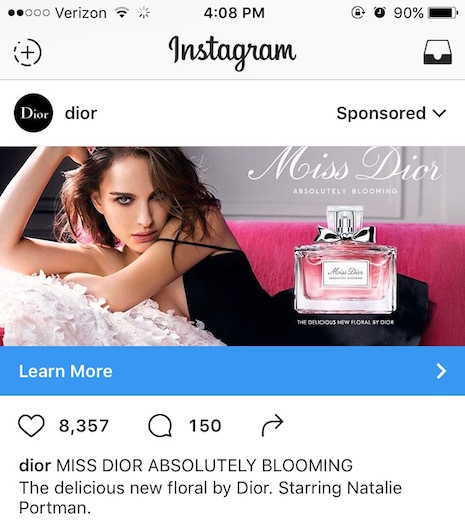 Scent of a woman
Scent of a woman
It is important to note that if you are promoting a specific product in your social media ad, it is essential that you drive those users to a page that directly correlates with the items highlighted in the ad.
Similarly to the example above, if you are a brand that has a beauty line, when promoting one of your fragrances in an Instagram ad, be sure to send users to the page that houses more information about that particular fragrance.
If you send them to a generic homepage after capturing their interest about a niche item, they are likely to drop-off.
When it comes to driving traffic to your Web site, if you have compelling content, vibrant visuals and the ability to correctly identify demographics about your target audience, advertising on both Facebook and Instagram can hold a lot of potential.
2. Converting traffic: Responsive site – your most important marketing tool
You may be surprised to hear that a Web site itself is actually your most important marketing tool.
A strong Web site is what connects you with your audience and is critical in helping to generate conversions.
As users go from each respective marketing channel to your Web site, you want the experience to be seamless.
It is not wise to allocate your budget towards marketing initiates aimed at driving Web site traffic if you are driving those customers to a Web site that is not optimized for usability.
To ensure that the user is provided with an optimal onsite experience, there is a certain Web site design that we always recommend.
Investing in a responsive design is essential. This type of Web site design guarantees that regardless of the device from which your users access your site, the design will render to fit the screen.
When users are on a tablet, mobile device or a desktop, they are always provided with the optimal version of your Web site. This ensures that there is no excessive zooming in or zooming out to view images, forms are simple to type and fill out, and all elements and functionalities work seamlessly on any device imaginable.
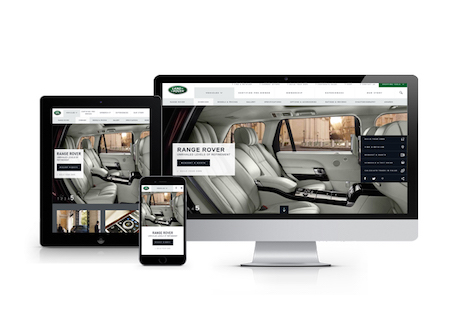 Back seats face screen test
Back seats face screen test
With a responsive design, the navigation and menu adapt to each device, ensuring that it is simple for users to search.
Landing pages are optimized accordingly, and buttons such as “buy now” or “inquire about a product” are optimized for the size of a thumb instead of a mouse and keyboard when users are on a tablet or smartphone.
As you can see in the example above, the Land Rover Web site automatically renders an optimized-version depending on the device that the consumer is using.
For those within the luxury marketing space this is especially important.
When buying online or requesting a quote for a product online, luxury consumers are moving towards a purchase with a high price point, so the user-experience is critical.
Any deterrence or trouble engaging with a brand, reading a Web site, viewing a product image or trying to complete a purchase can be detrimental to making a sale and, furthermore, retaining a customer.
3. Generating return traffic: Retargeting ads and email marketing
Once you have already captured the interest of a potential customer, re-engagement is essential.
In fact, most visitors convert on the second and third visit to a Web site, and not their first visit.
For luxury brands, where the products being sold are of a higher quality and price than the average competition, the user may need a bit more marketing and persuading to convert.
To drive return traffic and repeat conversions on your Web site, retargeting ads and email marketing are two of the most effective and cost-efficient options available.
Email marketing campaigns should be of value to consumers, otherwise they serve no real purpose.
Encourage users to sign up for your email newsletters with the promise of a real value that they can anticipate. Whether that is through exclusive deals or special promotions, there should always be a real incentive to become a subscriber to your emails.
Once you have captured email addresses, follow through with your promise and send content that truly provides a value. This is an excellent way to stay top of mind with consumers and subtly remind them about your products and services.
With the average user’s inbox being inundated with unsolicited mail, to stand out your campaigns must highlight something of value.
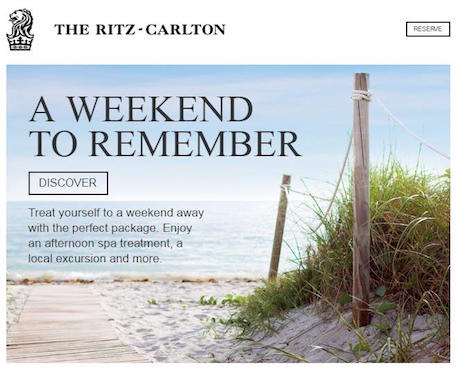 Sands of time
Sands of time
The example above shows an email campaign from the Ritz-Carlton. The brief message is compelling and highlights special services consumers could sign up for when they embark on a weekend getaway at one of the chain’s hotels.
For a user who has visited the brand’s Web site before and has considered booking a room, this incentive to discover what weekend packages are available could be the final touch needed to bring the user back to its Web site.
Retargeting ads are another great alternative to stay top-of-mind with customers as they consume content elsewhere on the Internet.
Through Google’s retargeting options or with programs such as Ad Roll, you can serve users who have already visited your site and expressed interest in your brand with compelling ads that reengage.
Depending on the type of advertisements that you decide to implement, you can serve users with ads that are specific to the exact item they perused on your site, activate ads that promote certain deals, or simply use promotional banners that help to build brand recognition.
Options are generally cost-per-click (CPC), allowing you to really make the most of your budget and only spend money on the users who click on the advertisements.
When you are targeting users who are already interested in your brand, products or services, you are spending your resources towards highly qualified leads, not just any potential customer that fits a general demographic.
ULTIMATELY, LUXURY MARKETING tactics can be incredibly effective when strategically implemented.
A tactical approach to marketing, an exceptional user-experience and a strategy that focuses on truly highlighting the value that your brand has to offer are often the key elements that many companies within the luxury space use to connect with their audience.
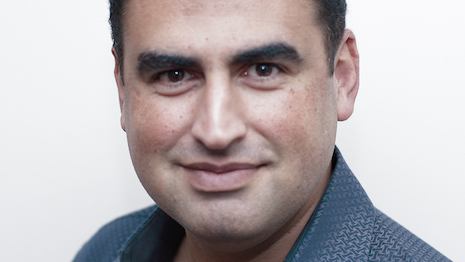 Gabriel Shaoolian is founder/CEO of Blue Fountain Media
Gabriel Shaoolian is founder/CEO of Blue Fountain Media
Gabriel Shaoolian is founder/CEO of Blue Fountain Media, New York. Reach him at [email protected].
{"ct":"G395cRggQn2+\/BUG+RocUGoRTi55Miz+LUgjpQ+gXZJbSKn2324c5+5SRYh8b6OfPrZXztIp9a7uQzW28yZ5C2NACAWqU01y0o2slv2WpBgwN7eHJw04KNIlTojwYfZ+\/bvkTGNZMh6a\/\/gNPl7PZDNBFmx50sD8g\/36DC1jse5GM\/cAX60wcLM1ljKTnhYW8TJBsJ5sg\/cH9FY0ZC2CJWIZ\/wxA2raAlG6XerGDEkiLt6oC8Cw0BcQWIU6qnASBs4sE81DCWJiKXtWG1DcdwcJAHrCksaDuTCIc0KwqiyoX2vNEuWCigish3M1fm4ZMLVXPFiSL0MWzL4O4Af50omjNpvrv7Pbbb5iPWBwr0y9Jpsj\/JKCY7mpM4soR5xcSebo2fSPQrrYHzjE3LSbJ97jvvmwplg+IKD0YAuIITGe9YqrmbVCIpw4325JVyIO9p6l+t12HJ9c9B9EkDczSBkjbSwQkJYCmHumxOPMMp0vs7keUxqSUDNtJeA3bmr94lNZk3+VyS7VgiupG51iCF621GDIcY47QN\/VDA9ygFIiEeAjQDC+9kLrK8lMfJBst\/kAa+ho\/uWcHYes94cpTaD9aZw1QJt8qw6jj2n9FPxEtBDuABNP1kZ5g2U0XHCBlbhGzJm93zsL5FKDX25TEzI9r0kgclV61riIVdqoABzd5XEo0VeupFY0ifRFHdX7PovKvkHKR3nuFW2Iup5NSnDBrc3JESTJps5zi+ETAp0RoCn\/WxbGuWqVwjX911l1EkK8b+pnM\/UU9WOLWxS6cBLX3jXxt9N22sXEaC3UHe7xvU9\/Txd1kT4VFYcbey+VPqtHQUT3RrMLJhkqs6zVCxtr6nVjF03f0uyfNHmk3OApwGOe820Xbn3W1xy4Ooai1LeiB1Sw4BWSCBoUqIajoYMFM\/v7xhJ7WW8zIiB6ucfpphgt6XLR\/FyjPpWmgkjbgDSLX3VeeRXS4A1XxSS514L9ctqloCYKFm0sbVyC\/GsPYFYHCjwunZoWs1Duh8toxpKL1UvE4eeJXloS5Vh+GaQ8Wdl7ltFjY2bskC9pm5ewjOWVs9YGPsczT47dEjpmzEfRZVpR7uMFwMfTKkgamBmwq0qKZQxaDnKFfvBKXaK\/B5ZR67W+4YKhp128CA9rbVRUSg4GYmblsOU5uqfW6ipGzBNGUYWYpc84zDMHMLlEIX0Pd2s\/lqfFOgqJA+UujfUisyLLMP4PkNBV+QFgrYqUGqYdOpivRRqSffZlyPoEyZT8UOUwWdFXASqSuwVHm5FZTqPg0bwxiuw8bKvSbeFqjih2qzuv886kpvSdqitHlTxDRS8NvRi3O+XsW3CoZRUx7Ojb0OA7ReTvZt7E66n7d7gYHb4TqriQYwqlgGQr4HcmLnrrEJ9lEg997E7IE2MYyuL93wSlBoU7shLWymeLetso9jffKtsNRSzZf9hkPJtMH5XdhZZK32iBQMoYpq+0kjBwsun55970IlirCXCHW7+NBIYQF2m0j0tU4xlp38tja+Iu\/HZLEmFp3yRCd2jBItnoIXETX91\/88nR\/eT0cbxQVScMAZwFHNKo+tCzhdgKudC4SQkYywf1y26BEwmYLS8nUmuuyPaA9xMUxPy4gK7k+KcuJpPdAB63SKtRr4W0SQOmOQYvpO+DywFmTgQlLBg2k7O8COnODuNzCCk0zqgSuJAhtLYW8t0W0VDtyTkN1ibc4qKL9WQcqBRQJBJj2ByuAm2SYrKc8Ihd2\/ePH1CMLSlsvjXVVj\/6I\/EIdLjGnu+AGuIpXe+IJ8+0\/b3YiXx0qrZGRrU6gSVCaZhgj9zChKoaM8Ydojp34UgDgVdADBG0vpnMoI3A7slmCd5txaUxTY0qwTtRs5touAsQ9yZA31ec\/Og9R13ohtq19iQXIeLYprv\/0EjfO7ssx8AQwe3qVCu17GdBhnxmMzSfabw3j5VF\/In9E1mePPZlBK+GfM5ggIJ5nbFWQF3NTfuhm0ae1bu1h+JsXcJgqSPWqb1lK2wmC50ksojRZEkODQT0FrXGhapcf3VnScX31GRxWm1C2vYOVbf6SLOzftPeYlip2sW34BAn5Duqf6aVxHfdy5PLbGOQo8MHRKahXcSq2aZdylENyzvkujFUbJsh02FxsQW30kyQqAbLITpRlsqz3xqg8g8icdkbgb7qxrMFOqM84BBXlVu0CYZ9xhw46GCFZ+dC65uGoF6fDtcB2FzgUyH3m5YHPLnbuWq9z8qJnu9PF78zRRT5bP8FgHsb64R3etdoAn8YY+c77ueilRR6ErzurkYOyDW7JpFhet0cNos9ipSleLXD\/HlqOOANlQGo7o3FGdroELLfOf0s8yl6RlIcG4NTFZI21k9T8P8qhOLxemeq+SIU\/ex06p+r29EyppIq8DeErgmQ4JWvIrHq5H7OE+evLCmbogAWCeKreQRxwdAc6\/4eSSLDf+Gde41tTJxYELmyrdkhKvob4ICmRbqtJ7MQyCvll+NSRDl402oMWEofUiWr34lW9IUxHd105w+IIGGXKR8IkiAvdmbaac7mNwqd0\/WYJG9dRo5gHKmpOlLVJ9X0X9vl8ephoQi9ThESu5ei3JEoa+XeGo9IUjFhT+6bOgA6Uk5ybvR4\/y930P8yQupr7Mqial2sghKsgDgsCXlbJDV\/HvuiFgUSyX54Y5uiuDG7DRJORgpn8KN6hPc0nTWgFCscSA4e0cS8JYpOTJrAEGipJGhdTAMGNE9XTfWL61N8kmSuNX6\/lohEMVfx9xicjNE00TsY\/sn5iTA8r3\/iG1VpPPv\/+vmGwz9fmXbDbv2w1ThNmTSDNI63QmIsKP\/YBgh6+\/AF2es\/l069Tas9M8TUNaMlMb9141ecfgVA3uZ4\/wPEDtBnAkvPu2LqU+RWCriBoCvaQkGARqrYwL8ugvOsT1tmkzyteIeo0lRqCytSYU7aHaSwXdPIz2hadG76JtnaRP3sgAdwSDZ+P84p+5QDRx0dlqU3p0gJRI4NKMFsPlQlVzgWSZGGokfcT2lTP9m7CWN46cno\/\/XAjzvyqk2MOmzwtPCu31mbhBsHVSSKoHbdNxRuuYSqgLu3Whv9gAPaAhswOfjTaxVtUaM6G7U+D\/k5160XW4qZlr55Avtx6yWtAIvP0Wmurg2EsvppxYyLsuSXfJzdT0wbsucWe1eVl+ZXrI1cfvjvSRLBiiu3L34fhp3Bi5r1rYHfIcscJE28R4rbGNxa5xvvlbYg76PHuP9KKpPPxoz4OwhouycUX9Rzdq8PF6ETdFRdSIdQIkjl9JOUMgxFpFOciG5jDbn6Z9\/OjCth15\/gBbxVAG8YVn5XukVARud8SLJGVXdr+lhddcb+18Zdqs60t253FWo6WaDT2W2jyIcc2Ce5A6M39qNSc8RqmwmXxE0CZ4jKh47q6zNZIlKh5WhMZfOTvx5hQogFoGh+leu+aai05cxFme2UhlgT4FbNl3gjdVehW\/oidNRGq8cfjeXJWl863cCNCqZ5LM9k7Biid\/aWewVmWH1HqVt7Zu89+NpQ59zc\/OijCKFeZgF+ii70Y66tVK9aSSlJTk3ETxZySwhlhNCzvzRcjf8e8FdA1r8IpBB8bK2OGUUazMMTS6etfg78cTSNNgugGL13vaoG\/A1uDpCFr0UiPicdjy7WRAp0xXe9tJJPpi9HItprtxlxmagqeTAJ7gTmzG\/qPfdo5CTCCmGAwSEENoKrg\/zPvEnSYV6PCIEU0HMQA6fDZOBDeptuvzBVgsRKYmSUtEKOX064oaQLglC7AwYH5o7G9VOUuF\/HuS3by\/pu\/DUXF239wogmpD4aFdts86mPSD6BT4KjBredQa\/FDISaSiYb7Wzof4IkHtJvmz4xsMxAxRQSEb89nrpJ+C5VZewDZDhqG4N\/bTeA7agApV3dnVFzANFex5K1H5MtQru2B\/O54MJFsGtl36W\/wzeD9p1GiU8AIlNdadpWGn3j6u\/JMJc43EFkGwOw8KIahBAGlDPkBJzhEDJsJk621tVgpusBtjmGMz\/XjUcgBQylF\/\/s3eOKWiJ4nRYTbBbAH3dqql9NFuGyVgmb1aY\/oVwMgsgftnEL3ZbY1w6AoZeyreL3FohhZ0Y6+tYsI8qJ\/oZ3kydWIAnTAJrwZu5yZYPaS7JY3PhxfneFpeJwvH0DCYglp64xW0AtMY7O5IXP+pAZDDAwtqB5Rgxi\/Y4SLmbYLH7NW5rrszje2Z0nC7ZKOsKKtvAPPiMJfHlfXGVaNLz2XwyxDKhnr5ZteYD31Nh3IWdtzASuGVboWcoGDRZE8b8i0ckdNMHuwOt7g8p0o9TZjpecRbEM0ZiPmxOQFK6dwbW2YXjjG30WxYbq+52CnVeE\/ahvvG\/fRpQr1OvCxlbxjVbJcd1Zhw9ACQSirUgDrE0Ya+HW7a\/sXEs6OPha6Y\/JqV4QdSOlasLI+fRJLjwpqJTlvYYmcsEXq2Q2Q82QN5V+Cr\/d\/skRRAXB5frixd7kM22edqexOybazIasFxBMybCQeOlM3Pa+KIzyrbY3By4aNiUXwHRGkbr8SJTsB\/rW8YztJqSeGC59fFGwPxdsz1nJxgl239d8MO6W7nSjPkWgjtlVmzGqCy\/V2d1lYJxCgyt5X7z+7+\/YBNQ8hRGf7s6fEHWN0eY2kw6HT6hpsdP4EKasNz7E5Z+I3E3oy21WMsdh1LHxbyb\/Tu61DQZl\/kKOnJooHP8IJ3OZYMK46oItYmPXaC3YvKMgpo10NeizeqTe7aLeJuhqh3F1ivKw0nzd\/BtN\/ih4OxCkbK6ZnNxmAS9mbnSmgWd+HFRXQcnKrnHUWhnadt1+e5JEzgQpMO0q8td0zEQWxlzfK\/\/sTdj4QQgqrvrbng0cx4dP1aeFIYtILx\/qn5zQWFAd9Bs5hH8ZDLjI+ADb04WS+Ezm+LMpPWCxd6idsMZPKvdWKIW\/Xb0KP4qS4gRwcT\/cMGmPcbtK7W1jhnCh4EW7ZN1koV8oy0g\/Cc+5Pw5l9lWHbbN5DZ4y+tLEw6d7DPJoFCPra23ZZ+bO4JK0FudytVUQM8n7SL+wn9YXUAOuzy4YqxAXEr98Kua52CGOW0sejwhv0WqKaSaa4Em0NLBMSXP92NWujGP5BccefddZwc\/l2YruI0iJFn9JE\/ZHJ2YWhOL42rVqrJPnByEBiKXRDcMYi5JZT3JQXX+q1E9mory+qjS+nob7wvvYu96p9LFyF74lT5hXLj+VOo7aBzv56Blpw1JpODs+pHh61vik3jAxktjDvFewbTg\/3VYq3F0VWUC5FW75WsahcVGmVb6Oh\/20RaMFyr2p9J4cH\/MIqZ+iJ8uhKUu6KD0LM3aX3hZR2VnJuzzpNwzEx\/sz8C0w7K0LSlbPaZYS8e0LAnoUGEn9ybjK9wI+e\/3wKncjm6CwiSm9vG9zjcizMZlZ46t\/+xBaLupucnYaQi8JKTNUyexUAYrWTPwhBu0FkC\/LOyNg9zw9S7LJ4GiIG2Cj49b5OeofvTmfgGZqYFRhhdygElctM0jKbszCG8nb5+8H2cEYtmO3MtrG7cJOpNefWbmcSI7JVDspcxZ6GsVAd3Q\/RjqGVQe9UEkfFMoiIC3VsmmH2mJBLoLktNojTcd7t\/LnFvuqVbHsjlocvMccIV644bRUowdlthOg7KpK5t3yCy65osZT1KinWbb6\/R\/ypvJVVEc8ZdM987nB1p69gb5H2ub5oKGfILgFbEpL3IHYE\/T4rF8BINKM6m3yulYyOKdI3f4\/pp70lL34RD4B8Qd8dy5kmkp3WZgcczuWosmw0M0F6Sxg6woeHDH++9mcPD0JrX9Jk\/1jRHlaOQ0mZ+s9QQRVtJeXpjhxJtX248PC2aKsciXC49uxdBBsLyOxZJSTBXOyhPjmHYc727x0luH004VGPiKf9s6dX0ofhBlwqZmWaeeDTiGPzxx6DpLej4T0wEPa16bOYMWJRxJDl50DJWhmdcRQEnn9JAQ4z+VUjeBSSIlTtRjSAL1z4HA\/H5RbDJS6cxWCE6pYaRB1k+WYbRMDCO5Q4ktL4K99PmuwQmRGIEKEcQ9vSAP7NBIGD3CvtFEMCrjwRvGG+\/UtOPhKAgl3tmEzDhf3kTyoPQzRRZSHYEFUlv7XRlGICzapfPYKW14pRcKk+OnSz2mcF6SmKc\/mlwhbJYfuP0ntM3PusNnBKXaSPZJAPruLlf736UR8AO5zB8ctRTlswHlJWeRPJNcvfZ6tzfkjTHAqOFR8Irkj4+j\/reQBcr6C3R+Xl+dOMwXDY8pVLlZfT01WqNK4m5eDAyzIQgmoRgqd1UBWUNMYg2WETmvThMm17LrqhEsg\/hRkoCpu981Sj2cW8Aayyt4aWF\/eqxGi92XA+2aD9X\/7F8v+PtGt2ChK06DBj0h7Y6wD+SRUNzyIF5bp8wzfVjQHI7goXMBK\/WHaiijuTIN9EafNqfnofq4BlKmO6jEslXVM0Tv16vADXK8FU+QbFR\/wEXEBLYMcILqYb\/H2XKPs+FY4IYSWChnOed4xZ2LIQw1hxFfTjJATEsiE1re3F0sTZqs2iy0Orgs2f4be6yGkQVzdu08Vt86BrVCT+2Ml33IMaKhVwWYZQP+NVL92OE0f9ubsclg08QhwbKymWk+84YQztwMsCy1+DcroBy+NJhrLVsHJ\/NE\/rPDwAad3EQsNVkNM+\/nme4c\/3LE6bdkjLrEuoAVrD8JET5U5A7tDrXwTDNRU4T458F66N+F5gcX7atVh54Nw1iAfDNqJDQnEpoUpjWcankRwa+qjlSq26\/64gSMFZa7c\/TX9LvrIVHaR1RUSRHLy\/Ym0qF\/URsjFsHHoEsDI4slId0E2EYekYr6hEfibXH7xn7POkTl5apzXJv\/PcerNk8gXvvP0JZZ74YYoQmx8i+VuRljfl\/LYCckUlQ1DVpNCH0EDOfKAouBnV9D8Y4dgTWCcEBuIAQjfbf\/cW8QBVSZgV6D8MuigDX5wfe2WBboYDOjtiSA5gFYPnPFwTEQ07zd2X+cUhOa2ncGSkAcN\/j6v9qudGpxFMoWyzql4Pw49OnLVYrgW7D++J7uxjO8E8qIzubCFqyhi3q5MAPh1wOZmxHW8\/hSXT3fbhLO36gMaJNhsxxBB5wWl6qcL6eIl0xpZUbnzWINFha6PbsVrWp3WQGJlZfQjkOVT0wvRyWY3FZXSX1MD\/80EYm0JtvGMI31sZVKI5gTYgFqTyGiD9XJvLLpvQw2dps1CNFbfI0dGCosRRfdhveEAwFBx3qQYlzLIp6GwkVmBpQJnlpn6jYV5lHJsWmbJ7cPhLNTy2Hlq+jY8As5Gcf2cGrUQU9rDhhJQqeLLMrAZLnYiemAf91mSOEoCe9ftP62Bq6cs8yW2Ld8QGPFz9SnQb22GvTYeIP8h8\/kYsasOxDyW4grLXttRdd8vUubAC5wcsN94EzDkjf1KEI\/xXMRekjJMOnGYPwxSe9XVFqIMxQmq\/fwM\/CECoNSOIKnVzuiy8hzdtBB00Ic7+Lc58RH\/T+HHHC3Dzss3zUePyJy2TSfM+09xnC8+tLZk7irbbDT3mYEI6eGvqTFP0tnv+Yk5M9bhBoEm1xinTAdOx\/F0awSMOM9j5omyF05q+ILhkfv6waMNLX\/KbrxF0m+PtpiSUhlc5y\/whzIf31j7YXYyvZMpWoZC7phi+OFOVz1TggJS3CmbXuiiysmJGiTbGXuxq0rK0lDTJX1\/5mB14QFgCIa2Ld0\/0ng13HTjKewu7A88JqnhY30eFbbieqdBMxqxRCUGAwfC6WaxSAOwNHrXIVU+3jHiEjmO5GsRT8JFBWh2jgQ2cULxsQYiJjo9wIBAkD1u4aoQGR5psgvc5+xhhji7bHkQJsEvzB62M7z50vDcBFpx0IL2gDzR5PB1gGKt+t3AI9RlG8TYNxbECmbKIrLuglbL7r1z2ekeXd1v6\/mVFfq84UEbBMlC9dzhZVAnv45abZmom0n8I6zjpr4xF6bAZxKgDAzRPxPdBSrqVR8x5UOm9myAXkV7XDstDUDT6xM\/YkTaXXYcmF3sahjMY0X19qUGqBuAKMusBffy6rMgRFM6SNZKPWrcgmBm+9C2vPC0zN3IR9OkEjnzsfyd52zvyE4H2FYFusjVlcZYwFdhy+DMP3Hlgeh2hlBMlWiWfXoirCJqsIG1T79+fY0nNji9ZybXbRNWXc1fXw1rzrSbTaoUOaVub3jCSTD7NH9ljvYs7cgE910PqZuEwxGJwQxGgC+wp9zZB8U6opCBSxsVI0ulDz4Hg2I44keuKjP8ggxg34p4oHWakx1rx6sFK+unDpuJ59ZJpwNJxrmdqQtQUNW9db4NFQ9ulHISEzTIelYNj3v3tqjcWuGCwvD7gPo\/s8L7YGZtRt7QDN1caN+Np0laKuDwvgK0E07sw7k\/JtLde57MVOOL8bYLNHH8hkrUGPBI4258+BATwJwIiOiDjpvH5jyfTXXIAdZGOVlNRfKfeYXfKTvM1iKt\/IqCHWrkUm+vbewNL\/umsgm\/cPQNtP5zg0Y1NM7uiPwnL2LrhWqvr3JrOdahOGydUl6UWJXN99Z4RxpXi68Tkz4pHfLMWvmQhIcDBE5R0\/uZpTx34kYgc1xBCWb5iCf4Dfn9dZ7RcNnUKjF0CZoL+y9fz3FA8CyLmJDf5fcJ3Rz60ZLt3C8gjsYk+11leLYNq0atTecw9ms0EppU+TDL+8Xa0sTi73URhspuToG0VrikdO0TTpRz4DhoaOdiRuQn854KfG0ZYPo\/fO2wOuggDk6i25H1zDvJAtYnHqRyZhEQqPZ1S0wjUH0nB4YFLfiMfo5\/Bp5fhR1sFvLZkAgUanzqI8Fx48b0Pa4iIwN2YEnEGDJz7EGkLvtv\/4Ne6EuFeiY1pXRjCcJBFMHC2VB8FUnQ1mBeAFsYHq6HUbL1m7C2ZsW9\/ccBVtfZ5uedHBuAHqwRYc\/oh8cSK3FBtVT7vXBUW9V9Zl4a7G0lOLtplw20MK4PXc3pxkLAjrOJ0n+kGU+H5BoxzYR4JYV8ZXo9JeYUlYVgih8g4f3Rgx6AlftwHeGdjtQ\/yzoFtAb1COI\/tyCCY73xcEh0JgIPz5ZzoPZzxc28+a26DT+sgZpN\/YPzLOkdT8fg1Y3YsnR2lGtNNrqJW0qbRhIR2Haz\/fFeEmP769+ZXsE826KzMlAdfWUYHrQFjFyb9fx\/RmG5ETr4X12ySCzVdsWgREGd1I\/OTcvpdSa+wj9TED\/efYnXlNegrPTOD0OxfYsCqiy6WlOtDRFzHzGll8alv+ZFiCrZIimu3z1XJX2R+lr\/Z4TRvK4l18Agj3ZONTsqPhoCcHAQUpb8UFVeS9lhrit3qiFXQfMbBBbqOYx8Cq1f8rnV+6wJRhaYoxPCzxwpPMJuTqBgFvoXxfldshF1SrhC2D24Hbo1\/viWOj9qt9\/M632E9USlsYK1NbghvqgP4otCtD8c5uvlEq761teOPTxmOpnKvr29EkiEbszxgDPi8Oz9gdWBKZGzDVLqbtM7M\/bCoryoPu4gBM73qDAUigqvwnluthVhvAhi1GpOTHfdsetIcEP9AMX\/dy3APDCW1ZlwnHAPYCpnkdKDRtq6VBZYza0IboA0F\/pdYwopEnFtZYEukK3G+2ZVrH19hGdscfGXLQFCqsEm9ERmv1oDBi4pb2vLudORDnsIfn1c0JKRFw1w36Gcf1b8Wfp1QWYpdU8VAyBUqrbR3OVMZguG0DVwAvIzvBSFKqdRpLVp0JZoFqC7k1IVL8rweVn0hiWx\/MZnTzCNkFY1eyah9+mXDa\/SLt7zxdt\/v2s6wE4S2rVl6QOl44PGc40OLH2zckvm+7goWCC3XvVudTevA5kcWkuKy8SqdczK09iaux8SJCIKtoTBkiyuMCweZwbQogWAt8Ckml6op9w4SEMPvbkCzVY5I2bBGutPul46bORRTBT62pMfxmBmZxMfpOVFcA\/VtWLngPGU+imBw3uRihXhJKyZJOOGGZuOLm8UIr2NO22XRXe7qs1W8aoqHccb\/ra9IZO4IqmcUmXXybPdFWVvLi2D\/RX\/HHMEPXdzF2pw9Ylvi7edwYsXgwvDPnPjlk5OOmfASJWaDJ4OzHUecLZs78\/o+e\/KDqyG3O6M4mz2YyPprYdFmfIw2fJ3kvdTaLEbArMBxoerbVyTNRxheRqZEHPp8GMSSDhwRvPG86WHtV619dEdKf6P1QpjGe19N6rfE5l4mCKelvPYazio33J0gSXttpPfGRfTXuEUu3BCOQs0nUHI63I7byMtnDAA2H6Il8SaOHOSia\/BWeonzMYhfTBuQigTlq8ki0w4vJiNuE+sB4gYkmn4Muvo\/9LLJ\/xn0QgFuoUh6MBm1kTlbJ+Dd3nUKP4wLBiqIHTIfkk9g596aeTdxYASoIlbCNBdT5rA\/hM9+KUk2l1NShjkSJX7c1yQzkijlBLLWulWIjvwf0WhgIWkp98RUstxutBNQclxWOWstC8Z2bJoPiZlSjn7+bgauSO3tQnkvHaescqiyYwDfKNvq7ekyylbCAYdbVT0XAHnLkfTIlPFIMe7NBN26vcr4NBXCnht5MftBNRwcfRfxozvcLkR99xvVL2d6nzNFyIZ7dp7XwCZtTR6rKh2VYOAt4qVLS7\/twa9Q7rVbrh+\/9Vxp4zWs+xgWo\/XFRBPTHAzdy+ciTNWIQBqxfSVG\/t2aHxrEYPWLy4hFmm3O+6q9K57hZBof9izcf+BeXclgY7Dauu1\/s0tnFxEWG6+QUQR3V9RuaWbZTF981UTvepJ5jWVqReiA7fYuTKEflCzKF0UWmQFvA8Cq9nte\/RYCXBDroym0JPffE95kxUeBzjK1HoChctLxH9FvHvn6MfkZiOBem1lqWvjfum5oWa3zbUlST2u4Tccu\/P7lXzZsxvDA4r0vBqrlYzzFx+Hkum941t3iByuSrBDq7EJTEWY+MQIO0W9CFB10CPU1gU4mqke7UwURT4bG69AXrxd9HUiDecGTT4HBTJnhuPt7vCYwELfWQxOKjBSZwVK55uSOCgCDlDi74\/8CXoTHhs8pSWbzqyFK8A6ftUHUdznX5DtHLG194m54OdvZ\/KB3emBBTqObjj1MTkvVDGsZwECpGOEtYG9ElMKfxVCwPCumRuSf7nD9P\/Ug1qYzikHQbOM6KjMsINYHxmMeg1bD4+jAX5KyOiXVUHGJGWIAZ0KIEGak3F3pNddsqd\/NtCwmiaAnuP8fXFBrXxwGq2567QzSM7iHRkgknlJb3mbAIVpEVKgCe+JN7c8QwU8u6kdWH4Nvtbq5zSBtr9LZesSw4EOr7XDOdy9B1yJCP6B27SO8oTQMIo7H9pl0GVhzJw+kDjpNiIk+4sSdet8zbbLRoL6xOoRePH\/MYINyTGd5VxzI+NHpGiTC+qzvn5LyypVR5NCa0ZIEfg8iKnsIpXFcfT\/yCtOc8tKYmyw6kaZyw1Gdj21+t7LKPpzqNd5q8uKp6PMd7dGxNQICzndOzWMgSUm2Rt2fuALYnyaPQ6l3carRnkbOFLrUAaFiiujXl6Y9qImwKjbw5R8diop+zeDXFMcpqsM0V\/G7GuvMFQ68PfDA039j71AEZuURT+ckSIkf\/82fnm4t4\/DnsVGh3xZqdcVW6GbRFJHznOdD2AguBp1yvFOo+ox94GvQgCNy6qG0j+XoDlOVYodtZ1lqR1imoh0dCUgPVDyimNu97j\/fk+e719hNlCRRglUpTk+viaVp496p83UW4t6tcK4IUGirOgwtNfW01COuW5Rx6F3H5zHwxYnesdfG22bwex4LsGBl8+RMcSCJaYmjf\/nVF+wlBv3kTlPRSqNwGf1ofLTg7fkcN565kGwZ1FtQAS9+76LZcu3JKMML\/tbj6cp2lltmtb2qBl4KmLKdrU\/NPGdFZ3KZuvjDNRJFv\/6hiAb7GqTOb91I7K35\/Pp25xM1Sa\/V1fBx280c6GLT4zjGy2lSHinfUmDSZdERpgH8c9h5O8bl08frDF9Q2wHzEJlpXaLlDchZjstyFpw862XotpESir\/kkkDDpLi9v1Sz\/zuXUwGqYm6DmS\/wfdzUXke6GxBkJdENTF6+e8HxTvig+j7c1p\/XbbR3UVz8qTvUfHygI4Z9q3JtMpNBni4o6c0n3KRZ+7f1\/\/akNnLnXFBvPnVsmLNmGQutzqLeB\/zpyEtltxj\/gXEdFDORzdWfwa1wWvN98q8KZLdlzS0JHiKq4nhoItN9qbxzvRGo9Yk4bfoILD6aN0LnQHtAm\/MGR\/c\/6ZZ7QDuWwqHSSLR1la9sGLeYStvPcTTHkeLerskUuq6\/5Flys013c\/obAp3hqRMuSSyd8498hFrnKT92l3RdYjxY\/7khIMzkxrfaobdMDGFRP7e2gHOFi2BxDPr65nXE7jm3ezXMYgsqwS9pYRguOUcSki7rfvXZFIsp78C5USZEETxBSAqbrZYmtqRyeBFaNkbAfiyL+Lxz\/pWaOYIIlE+CRT+YGdu0f+FDeDF2bpb8cZYPFk89gk\/EWSSsEm0UQz1F35qvsjBAoTUOh95jdLO0\/sZVmLPryPUSx5NmjVuCwj6ee8G3bJuvUYl2QJdQ\/9UjQypJ3tFLgXLFyn5XRi3\/6oOrYNy\/UBg5KsOQI6Mxpz2RdP2LU+AljGSDhk9VVSbdJrrFkgs07PkxHdc3K\/U+9CWxQiqOi9jlc9\/tg0nJKLCR7zH3pT+U5wsoJGGYusjIUQLBHae3ihpjW290LgUICPMsv9oZ7TxWcTAs98\/b8fdERnqHQCoNGRCncfPB3M+l6P4X6+XCB5vXs9p9IK5eDRWowQBeWIEnMD\/BO3zCkKjDvms5y3ptcZok7ZkOWfw16c8VNMY0QSaMIr+UbWyWEe13IBxUxFlDRdBqciL0ZCKS\/sgLGH\/1tvopy0TsAHOnQGRPS75g66UlJHic2OI0poK3rLIH3Qohw\/gdSI6xRpv1oAJErQhpq+89q0XvZjgpaG1V1osUZxD4kDlVM44\/tfaP5+VmCHRxr5DWIftyGa7eaTMHYxrVGsvaFWpTdUSZJeb2nBolMgomNVQKidTnrkdQwu7GA62JNYVX3xhrzt5KaEBmlEbLk4RnBUZAWwWu8OTLT66nJxAYiIwp77r2Xh5UxNhIZYdBkvDjHlXcHtFOpDTBTJ\/3egD7R33t7dSNPZe0xmmku\/CuQjohATUvOqXBIpXOxP5Wxfmf2a49IRqChg0j\/Pg5dZkxT5pJ0exdk5tQ4WBMmLr3M58MVKzroJPatMB9PndrR4x6g2s2pYhwQeg+jEvzzZA5+1BUgmxRkkcZuBA87nRnu6h9SOG7jsq1bePfROwL2gPMXOV40tI5+m\/et7CxjAzS6J8ETzzIIlCWnvhBEJdHlmm8cZo1m+BByc1Ut4I+oj72SVRonnReuZIVZv7hC+71gVsXq350Oonk+2V4iHDmSaiZkF1VdRoPzR4ueaSv1eyhZyFKAlJQDNXf1W3Ev0ESDeMH+w7ykUpOeomV8ilT6DeTIlwJbKQg4k\/liP7\/+3\/+1c7QA+YuspPU2maIBhaiV4oFWyVmRjKrtaQXr4Fqa6PHX\/4\/XkG7\/FmESL4aKCEiAFC5xfZiry5Qt6ywyJOWvtSTguift3MMbtvpSm\/duSOMCWuH5avcQY2MrEg6hH+MffHJHQzi+YmVaMxrQdLufEFocc4eDTVJF3YmOGBVUS7CChsgjtFb9pbE\/BcCFD3gsrHtafbk\/wH63ECB565jhrq6B1RON9aA8O0S0Mt+DmaoJ4SXFRafanqrDJm1CbEIsfojGnItZMeqVYGgLoPedn9hMeG2yNqCIoyJlj\/pwB\/ltYzKIys8FAD96TY6y4+cjDAMWjaDJ1inxu2kX4A9aUqqrWSZu9aQCCHXK0opwea5kF++pBo+iYH0oaQS92y3S2mReoE2tFK05uUxOjPqc8urkwe1KAeECEVMC1jTyg+OBz8mSQRbahYzj46cCbK8Oi87lj7Gs5EELxvA+1IEWFaCB5\/TobUA2GBEr8qQDMDXKLCby1WpMKQA4fbIsE9dIGu0ucoH5buK0tDi\/tZZbM\/X182NqnA3oYidPYBaFaFpvVJE4dPJ86B74cf68uHX3nvWk4+HBP6OtFsYwZO6soKwFCTE8Z3w4KMO0kJ9vybtatLnuIsDzdOIxo4NERTOCT4sByoQRmG2jpdz3Np0s1yyH8L1UFhDQXM7tCBFd3T\/YhXh59WR\/VhhWPAh4YZQLBLtsHPH\/SKFI6Ekxyb2idy66OMgssGL\/SU0D+V6OO8A5M6891+FJAiln\/LqiwhQRoSY\/Doy1nlbr2EINWS9nhfZmY629+jxWiZakjozu3DNrApzwRxFTcrZYulUCZcHXVPH3tMe73pPVq\/KHtYSh1O+8vDKlSA4Ne9DfvMyJf6YjuG0lzjGRpI0F8v0a6PvAOw8lG8sBUqoR+RZC3dbWax9odnl815HgrlkbU6arlRhr7Dow9dgoq5DW4nku3QLk0Ox6XMK9sweU2DDYTgvclv6VzMngrgt8r5NwkEbV7huKp9Jg6JzxbmPYRBSst6W0QowBVa1J7JIAT28+RRs1gLIMlngkrzTbqLGjxVyEec4BCiJXLb0RDkHLk+LPCzdOFmqr2HHetuDKI3qxaNc1DSe\/zM4PoXE8lueztp66xI4X3vP4A2MnzgBxICS9WnsHDwt3yHqXqTVPb43ONQRIuyfXnPEennEzLiilRmWUjLCALfbMoACwNfBUgC69NRYw+rMNPrBhErVVQsj0kOP\/SBrWLimseTp1XQC6mM6cLIcqsqGErIhhWw3+FQpyPnnS35UWMRHBReF71VXjTAEVMkRbaNYZJmiTgml2WgHirU15m71Z7uvHWMd2DHOZxjpATpORAxhGvU1zEAbAiZCRVLmVrrV+zq33ZhoenUuBEBuqnShFg==","iv":"0bc66229787845f3df6bdd6dd2940b5c","s":"5899a5b392395b6c"}
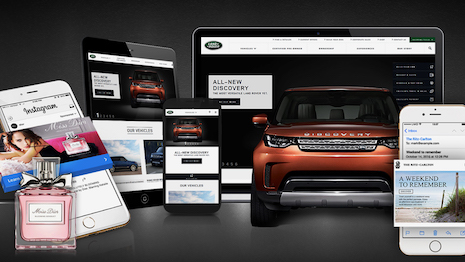
 Land Rover in a Discovery phase
Land Rover in a Discovery phase
 Scent of a woman
Scent of a woman Back seats face screen test
Back seats face screen test Sands of time
Sands of time Gabriel Shaoolian is founder/CEO of Blue Fountain Media
Gabriel Shaoolian is founder/CEO of Blue Fountain Media